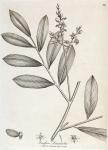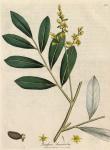
 Also see 077. Quassia amara. Bitter quassia.
Also see 077. Quassia amara. Bitter quassia.
["This tree is known in Jamaica by the names of Mountain Damson, Bitter Damson, and Stave-wood. The shops are supplied with this bark from Guiana; but now we may have it from our own islands at a moderate expense." Wright, l. c.]
Synonyma. Simrouba. Pharm. Lond. & Edinb.
Simaruba amara. Aublet Hist. des Plantes de la Guiane Françoise. tom. ii. p. 859. tab. 331, 332.
Euonymus fructu nigro tetragono, vulgo Simarouba. Barrere France equinoxiale. p. 50.
Le Simarouba vel Bois amer. Des Marchais Voyages en Guinee et à Cayenne, vol. ii. p. 124. Bancroft's Nat. Hist. of Guiana, p. 84. A Botanical and Medical account of the Quassia Simaruba. Wright in the Transactions of the Royal Society of Edinb. vol. ii. p. 73. & seq.
Class Decandria. Ord. Monogynia. Lin. Gen. Plant. 529,
Ess. Gen. Ch. Cal. 5-phyllus. Petala 5. Neclarium 5-phyllum. Pericarpia 5, distantia, 1-sperma.
Spec. Char. Q. floribus monoicis, foliis abrupte pinnatis: foliolis alternis subpetiolatis, petiolo nudo, floribus paniculatis. Supp. Plant.
This tree grows to a considerable height and thickness, and sends off alternate spreading branches: the bark, which covers the trunks of the old trees, is black, and a little furrowed, but that of the younger trees is smooth, grey, and here and there marked with broad spots of a yellow colour: the wood is hard, white, and without any remarkable taste: the leaves are numerous, and stand alternately upon the branches; each leaf is composed of several pinnae, nearly of an elliptical shape, on the upper side smooth, and of a deep green colour, on the under side whitish, and stand alternately upon short footstalks: the flowers are of a yellow colour, and placed on branched spikes, or long panicles: the calyx is small, and cut into five obtuse erect segments: the corolla is divided into five petals, which are sessile, equal, lance-shaped, bent outwards, and triple the length of the calyx, into which they are inferred: the nectarium is composed of ten oval hairy scales, inserted at the base of the filaments: the stamina are ten, slender, equal, about the length of the corolla, and furnished with long anthers: the receptacle is a fleshy substance, of an orbicular shape, and marked with ten furrows. The female flower, (according to Dr. Wright, whose figure of the male plant we have given) is never found at Jamaica on the same tree which produces the male flower; it is furnished with five roundish germina adhering together: the style is cylindrical, erect, about the length of the corolla, and divided at the top into five recurved persistent stigmata: the fruit is an oval, black, smooth, fleshy, soft pulp, or drupa; the number of these drupae is five on each common receptacle, but seldom more than two or three arrive at perfect maturity, when each contains an oblong pointed nut with a flattish kernel. It is a native of S. America and the West Indies, and flowers in April. Although the medicinal bark, which the roots of this tree are known to furnish, was first imported into Europe in the year 1713, it is but a few years since the Simaruba was botanically ascertained.
Linnaeus at first supposed it to be the Pistacia foliis pinnatis deciduis, foliolis ovatis; but in the second edition of his Species plantarum and Mat. Med. it is recorded as the Bursera gummifera, and both these genera are referred to the Terebinthus major of Sloane, or the Birch turpentine-tree of Browne. However Jacquin, who examined the root of the Bursura, and compared its bark with that of Simaruba, found it to be very different. Linnaeus therefore in his observations on the Mat. Med. published in 1772, very properly mentions it among those plants which are not sufficiently determined. About this time the Simaruba tree was discovered and investigated at Guiana by Aublet, and at Jamaica by Dr. Wright, from whose specimens it evidently appears to be a Quassia, and under this name it has since been described by the younger Linnaeus in the Supp. Plantarum. Dr. Wright, to whose botanical researches we are much indebted, says, "in 1773, specimens of the fructification were sent (from Jamaica) in spirits, accompanied with a botanical account of the tree, to my late worthy friend Dr. Hope, Professor of Botany in the University of Edinburgh; also some dried bark from the roots. The following year specimens with similar description, were transmitted to my late learned friend Dr. John Fothergill of London, who sent them to the celebrated Linnaeus at Upsal, as appears by Professor Murray's Apparatus Medicaminum. [Qualis vera ejufdem arbor sit, jamjam Aubletii indagine cognoscimus; ut tamen et mihi monere incumbat, b. Linneum, Equitem, litteris jam a. 1776. ineunte mihi datis, antequam Aubletii elegantissimum opus illi innotesceret, significasse, Simarubum Quassiae speciem a se haberi. Ille autem Simarubae cortex, quo cl. Wright (Conf. Bibl. mea med. v. iii. p. 483) arborem in Jamaica vulgarem vestitam esse innuit, pariter in alvi profluviis efficaci, discrepat a vulgo usitato cortice, ut specimine mihi misso reperic, quod scilicet tenue est, tenacius, longe pallidius, obtectum extrinsecus verrucis exiguis sere stipitatis, valde amarum." Vol. iii. p. 458.] Dr. Fothergill caused elegant drawings to be made of this plant, and these drawings I now have the honour of presenting to the Royal Society of Edinburgh." [L. c. p. 74.] By the assistance of Mr. Alexander Anderson a plant of this species has been lately introduced into the Royal garden at Kew. [See Aiton's Hort. Kew.] The cortex Simarubae of the shops is the bark of the roots of this tree, which, according to Dr. Wright, "is rough, scaly, and warted. The inside, when fresh, is a full yellow, but when dry, paler: it has but little smell: the taste is bitter, but not disagreeable." "Macerated in water, or in rectified spirit, it quickly impregnates both menstrua with its bitterness, and with a yellow tincture. It seems to give out its virtue more perfectly to cold, than to boiling, water; the cold infusion being rather stronger in taste than the decoction; which last, of a transparent yellow colour whilst hot, grows turbid and of a reddish brown, as it cools. The milky appearance, which Jussieu says it communicates to boiling water, I have not observed in the decoction of any of the specimens which I have examined." [Lewis Mat. Med. p. 606.]
This bark was first sent from Guiana to France in 1713 to the Count de Porchartrain, then Secretary of State, as a remedy of great efficacy in dysentery. In the years 1718 and 1723, an epidemic flux prevailed very generally in France, which resisted all the medicines usually employed in such cases; small doses of ipecacuanha, mild purgatives, and all astringents were found to aggravate, rather than to relieve, the disease: [See Wright, l. c.] under these circumstances, recourse was had to the cortex Simarubae, which proved remarkably successful, and first established its medical character in Europe. [Jesuitas patri Soleil collegio Parisino adscripto anno 1713, qusedam hujus corticis specimina miserunt, ille in dysenteria gravi, quae anno 1718, Parisiis surebat, jussu Regio, suit tentatus, bonos inde observatos effectus, anno 1723, reiterata experimenta uberius confirmarunt, variis itaque in locis in usum tractus efficaciam suam in sislenda dysenteria ubivis probavit Degner, Schwenk, Tissot, Grashuis, Boennicken, Werlhoff, testibus, efficacem quoque in alvi fluxu chronico & lienteria Schwenk, Tissot, Boennicken Jussieu sunt experti, in haemorrhagia uteri Du Buissbn & Jussieu: has ejus virtutes non modo a vi adstringente, qua pollet, pendere, sed illam ipsam materiem quoque horum morborum corrigere & e corpore educere, Schwenk & Jussieu ex eo probant, quod sub ejus usu excretiones aquosae promoveri observentur. Spielman Mad. Med. p. 228.] Dr. Wright says, "most authors who have written on the Simaruba, agree, that in fluxes it restores the lost tone of the intestines, allays their spasmodic motions, promotes the secretions by urine and perspiration, removes that lowness of spirits attending dysenteries, and disposes the patient to sleep; the gripes and tenesmus are taken off, and the stools are changed to their natural colour and consistence. In a moderate dose it occasions no disturbance or uneasiness, but in large doses it produces sickness at the stomach and vomiting.
"Modern physicians have found from experience, that this medicine is only successful in the third stage of dysentery, where there is no fever, where too the stomach is no way hurt, and where the gripes and tenesmus are only continued by a weakness of the bowels. In such cases, Dr. Monro gave two or three ounces of the decoction every five or six hours, with four or five drops of laudanum; and found it a very useful remedy. The late Sir John Pringle, Dr. Huck Saunders, and many others, prescribed the cortex simaruba in old and obstinate dysenteries and diarrhoeas, especially those brought from warm climates. Fluxes of this sort, which were brought home from the siege of Martinico and the Havannah, were completely and speedily cured by this bark. The urine, which in those cases had been high coloured and scanty, was now voided in great abundance, and perspiration restored. Dr. James Lind at Haslar Hospital, says, that the Simaruba produced these effects sooner and more certainly, when given in such quantity as to nauseate the stomach. Dr. Huck Saunders remarks, that if the Simaruba did not give relief in three days, he expected little benefit from its farther use; but others have found it efficacious in fluxes, after a continued use for several weeks.——"My own experience, and that of many living friends, are convincing proofs to me of the efficacy of this medicine, and I hope the Simaruba bark will soon be in more general use." [L. c. p. 78. It may here be remarked, that Dr. Cullen says, "we can perceive nothing in this bark but that of a simple bitter, the virtues ascribed to it in dysentery have not been confirmed by my experience, or that of the practitioners in this country; and leaving what others are said to have experienced to be further examined and considered by practitioners, I can only at present say, that my account of the effects of bitters will perhaps explain the virtues ascribed to Simaruba. In dysentery I have found an infusion of chamomile flowers a more useful remedy." Mat. Med. vol. ii. p. 75.]
Dr. Wright recommends two drams of the bark to be boiled in twenty-four ounces of water to twelve; the decoction is then to be strained and divided into three equal parts, the whole of which is to be taken in twenty-four hours, and when the stomach is reconciled to this medicine, the quantity of the bark may be increased to three drams. To this decoction some join aromatics, others a few drops of laudanum to each dose.

